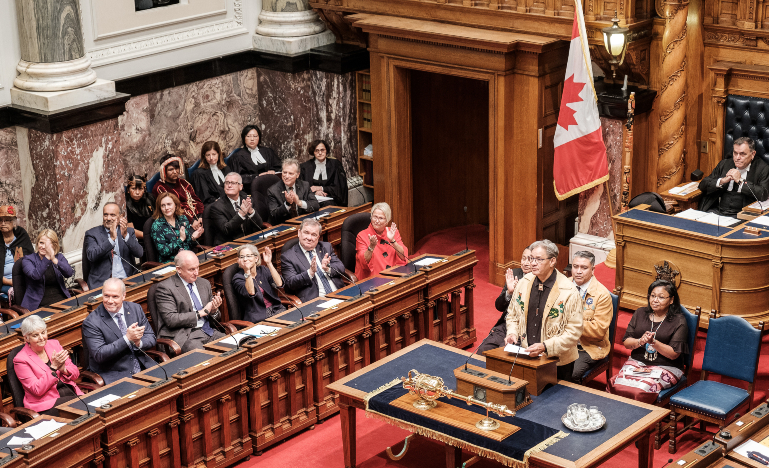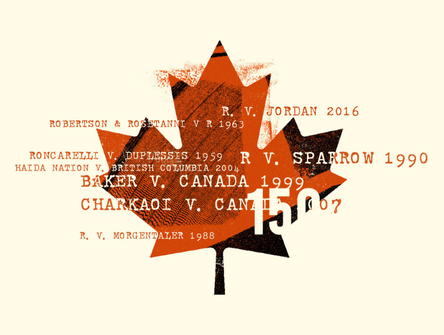The power of law
Recognition of Indigenous law is making gains in Canada, but the courts remain timid.

The recognition of Indigenous law in Canadian courts is more tentative than some might think – or like to acknowledge.
However, Dr. Dwight Newman, the Canada Research Chair in Indigenous Rights in Constitutional and International Law and professor at the University of Saskatchewan's College of Law, says recognition is coming through other avenues.
Speaking to a recent Canadian Bar Association panel on the interaction of Indigenous and western legal orders, he said increasingly recognition is happening through modern treaties and statutory mechanisms outside the courts.
That said, there is a possibility of change within the courts in light of the United Nations Declaration on the Rights of Indigenous Peoples (UNDRIP), which the U.N. General Assembly adopted in September 2007. The international human rights instrument affirms the minimum standards for the survival, dignity and well-being of Indigenous peoples worldwide.
In Canada, the United Nations Declaration on the Rights of Indigenous Peoples Act received Royal Assent and became law in June 2021. It was a response to a call to action set out by the Truth and Reconciliation Commission and requires the federal government to consult and cooperate with Indigenous peoples to ensure federal laws are consistent with UNDRIP.
Newman says it's a challenging area where things are still evolving, and "the answers the courts are going to give may be years down the road."
Currently, the leading Supreme Court of Canada case on Indigenous lawmaking is R v Pamajewon, which dates back to 1996, and determined that a claim for a right to self-government under s. 35 of the Constitution Act 1982 would be adjudicated under the test set out in R v Van der Peet.
The decision didn't give any general recognition of Indigenous government or Indigenous lawmaking, as the top court said that it would analyze the development of particular laws in an almost 'law by law' fashion, or at least' topic by topic' to see if lawmaking on that topic met the Van der Peet test. Newman said the result was restrictive, given the need to meet evidentiary requirements.
"That's a very challenging prospect," he said. "That's where the Supreme Court of Canada has left things. It's not the most practical (decision) in some ways. It may not seem entirely principled considering where we are at today, but in some ways, it fits within Supreme Court of Canada case law pretty neatly. There hasn't been a major change since the Van der Peet decision."
However, the day of revisiting the issue could be coming soon.
The Quebec Reference to the Court of Appeal of Quebec Re the Act respecting First Nations, Inuit and Métis children, youth and families is now headed to the top court after the Quebec Court of Appeal recognized that s. 35 of the Constitution Act contains the generic right for Indigenous self-government. The decision, which came down earlier this year, has "very substantial statements" on UNDRIP and lawmaking by Indigenous governments, Newman said, so it is very much one to watch for what the Supreme Court justices will and won't say.
In British Columbia, the Supreme Court's Campbell decision in 2000 found that Indigenous nations have an inherent right to self-government, protected by section 35. That case focused on the self-government provisions of the Nisga'a Final Agreement. The provincial government had tried to quash the $487-million deal, which granted legislative powers and land to the Nisga'a, with former Premier Gordon Campbell describing the treaty's approach to self-government as a "recipe for chaos."
While the case has been widely cited, Newman noted there haven't been definitive affirmations of its key principles, specifically the place of Indigenous law as being outside sections 91 and 92 of the Constitution. In the closely related decision in Chief Mountain, the B.C. Court of Appeal confirmed the lower court's ruling upholding the constitutional validity of the Nisga'a Final Agreement. However, there were more tentative statements about that kind of Indigenous law power in light of the treaty arrangement, with the court making no pronouncements as to its inherent character.
The courts are somewhat tentative about recognizing a section 35 inherent power of Indigenous lawmaking, says Newman, even as they show a readiness to recognize agreed treaties.
In the context of modern treaties that recognize Indigenous lawmaking, there are statutory recognitions at play as well, most notably the Declaration Act in British Columbia. It seeks to implement UNDRIP in the province and includes provisions related to consent agreements. That allows the provincial government to agree to recognize Indigenous jurisdiction in some domains – something that was not included in the federal UNDRIP legislation. This special statutory recognition led to the first agreement of its kind earlier this year between the province and the Tahltan Central Government, which will see Eskay Creek mine (located in Tahltan Territory) become the first mining project to have permits authorized by an Indigenous government.
Asserting jurisdiction where there is not necessarily agreement or the backing of a treaty is another, more tentative undertaking, Newman noted, as tensions can arise among provincial and federal governments that have laws on the same matters and other neighbouring Indigenous groups with overlapping traditional territory. He said there are also challenging questions for anyone who can be impacted by that legislation, as to how they regard it and what force it has in a Canadian legal environment.
In these instances, the question is whether the Indigenous law will be recognized and treated as having paramountcy or subject to it? Currently, there is no clear guidance on this question, but there are interesting cases to watch in the pipeline, including one before the environmental appeal board in British Columbia. It involves the ?Esdilagh (Alexandria) First Nation leaders' enactment of the Elhdaqox Dechen Ts'edilhtan (Sturgeon River Law) in 2020 to protect the Fraser River, which runs through their territory, and other neighbouring First Nations.
While courts have also engaged with Indigenous law in the context of conflict of laws, Newman said they are reluctant to get into this doctrine. There are several reasons for that, not the least of which is the awkward dimension that arises in calling Indigenous law foreign law, even though when assessing conflict of laws, the law of one province relative to another is considered foreign law.
"Canadian courts aren't rushing in that direction," he said.


